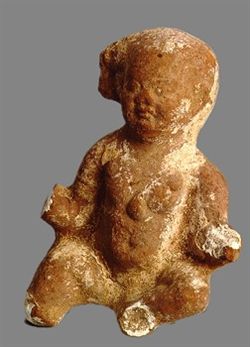
Bezeichnung für gebrannten Ton bzw. die daraus hergestellten Statuen. Sie erscheinen in Ägypten erst ziemlich spät und hauptsächlich unter dem Einfluß der griechischen Kultur. Bereits im 6. Jhdt. v. Chr. stellten Griechen in der Stadt Naukratis im Delta Terrakotten her. Eine große Zahl von Funden stammt aus Alexandria, wo es eine regelrechte Industrie gab. Bekannt sind auch die sogenannten Faijum-Terrakotten aus der Griechisch-Römischen Zeit, die nach der Oase benannt sind. Terrakotten wurden sowohl von Hand als auch in Modeln geformt. Bei Figuren wurden die einzelnen Gliedmaßen häufig einzeln hergestellt und dann zusammengefügt. Es gibt viele verschiedene Arten von Terrakotten, darunter auch Statuetten von Menschen. Dazu gehören die sogenannten Grotesken, Figuren, deren Körperproportionen oder Mißbildungen in sehr übertriebener Weise dargestellt werden. Weiterhin gibt es alle Arten von Tieren sowie verschiedene Gottheiten, wobei die beliebtesten Harpokrates, Isis und Sarapis waren. Außerdem gibt es Porträts von Königen und Königinnen der Ptolemäerzeit, Miniaturhäuser und -tempel, Tonlampen, die häufig dekoriert waren, etc. Die Ansichten über den Grund für die Herstellung von Terrakotten sind geteilt. Viele Statuetten wurden in Gräbern gefunden, aber ebenso viele auch in Häusern. Heute nimmt man an, daß es verschiedene Herstellungsgründe gab: Grabbeigaben, Votivobjekte, das Aufstellen in Häusern und Heiligtümern, Amulette, etc. Natürlich ist es auch möglich, daß ein Objekt für einen anderen Zweck wiederverwendet werden konnte.